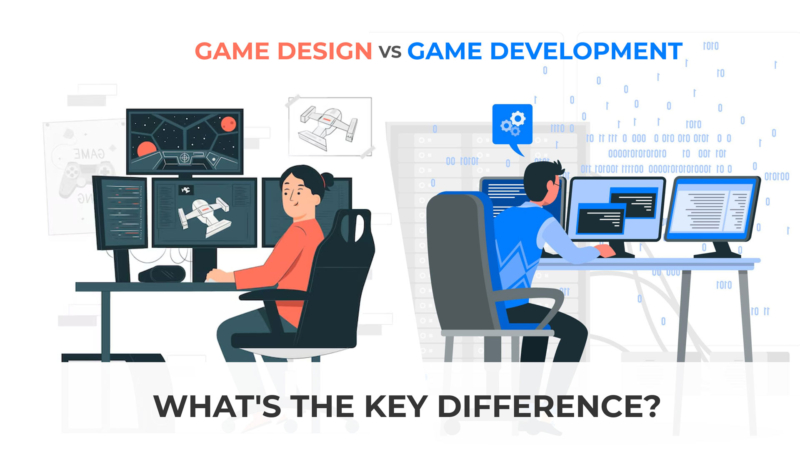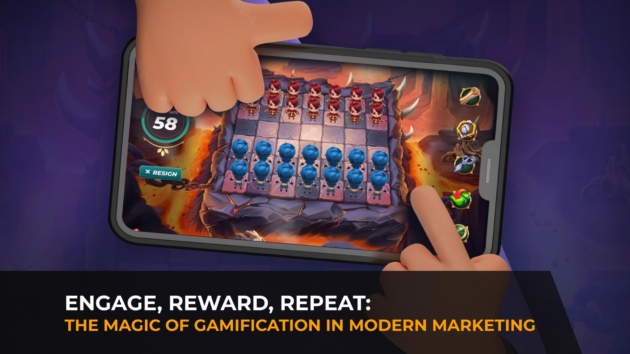Game design and game development fundamentally differ. While the terms are often used interchangeably, they represent distinct phases in the intricate journey of bringing a game from conception to reality.
In essence, game design can be viewed as part of the overall game development, although some companies offer it separately. It serves as the stage where the project’s blueprint is created.
It’s the nucleus from which visuals, narrative arc, and game mechanics all spring forth and it encapsulates all the artistic vision, storytelling prowess, and UX intricacies that aim to captivate players and carve out memorable gaming moments.
Game development, on the other hand, is where conceptual frameworks come alive, and abstract ideas become tangible digital reality. It includes the technical implementation of the video game — the coding — and the iterative refinement required to translate graphical designs into playable titles.
For a video game publisher, navigating efficiently the nuanced interplay between game design and game development is paramount. It entails fostering synergistic collaborations between prolific designers and proficient developers and harmonizing creative ambitions with technical feasibility.
In this post, we will discuss video game development and design and share some expert insights into how design and development projects are executed here at Stepico.
Differences Between Game Design and Game Development: The Services a Game Designer Offers
Conceptualizing Gameplay Mechanics in a Video Game
Game designers are the architects of the player experience. They delve into the core mechanics that will drive engagement. This involves crafting a compelling loop of challenge, reward, and progression that keeps players immersed in the game. They also define the genre (puzzle, strategy, RPG, etc.) and explore innovative ways to interact with the established practices within that genre. Additionally, designers can consult with clients to advise on the best style (realism, semi-realism, stylized, and so on) to complement the chosen game genre, ensuring a cohesive and engaging experience for players.
Narrative and Worldbuilding
They also craft the narrative, establishing the overarching framework upon which the artists can then create characters and the fictional world that will serve as the backdrop for gameplay. Establishing the lore, atmosphere, and overall thematic feel that resonates with the target audience is among their most important goals.
Rule Systems and Balancing
Every game operates within a defined set of rules. These rules must be developed properly to ensure clarity, intuitiveness, and, most importantly, balance. This stage encompasses aspects like difficulty levels, resource management systems, and the conditions for victory or defeat.
The Services You Get from a Video Game Developer
Realizing the Design
Game developers bring the designer’s vision to life. They translate the game design document (GDD) into functional code, building the core systems that govern movement, combat, artificial intelligence, and other elements.
Game Programming – Features and Game Mechanics
While it’s the designers’ mission to define mechanics and features, the engineers are the ones to implement them within the video game utilizing programming languages and various development tools. Proficient game development vendors, such as Stepico, are always well-versed in the latest advanced technologies and game engines like Unity, Unreal Engine, and others, which enables them to consistently deliver five-star modern games.
Prototyping and Polishing Gameplay
Engineers collaborate closely with designers to create playable prototypes that demonstrate core functionality. This is followed by refining gameplay for optimal player experience. The necessary systems are employed, and both teams work iteratively to fine-tune mechanics, difficulty, and immersion. This iterative process continues until gameplay feels polished and aligned with the initial project vision.
Adding Sound and Animation
Development experts work extensively with sound designers and animators to integrate audiovisual elements seamlessly into the game. Their job is to ensure that animations and sound effects complement gameplay mechanics. They integrate animation assets into the game engine, implementing animation systems and ensuring smooth transitions between different states. Simultaneously, they incorporate sound effects, ambient audio, and music tracks, synchronizing them with in-game events and actions. Through feedback loops, developers, sound designers, and animators polish their work to achieve a cohesive and impactful audiovisual experience that elevates the overall quality of the title.
Incorporating Artificial Intelligence and Implementing Logic
Another goal of game developers is to create intelligent behaviors for NPCs and implement logic systems that govern the gameplay. They often use AI algorithms to get NPCs to perceive and react to player actions, perfecting them gradually through testing. The aim here is to ensure that AI behaviors support the intended player experience. Additionally, game developers create logic systems for various game mechanics, such as puzzle-solving and quest progression, shaping the game world’s reaction to player inputs.
Working on Physics and Graphics
Developers focus on implementing realistic physics simulations and visually striking graphics. They utilize physics engines to simulate natural interactions between objects and environments, integrating physics-based mechanics like ragdoll physics and dynamic weather effects. Concurrently, game developers collaborate with artists to craft high-quality visuals, employing advanced rendering techniques, lighting effects, and detailed textures. Through step-by-step refinement and optimization, developers ensure a balance between visual fidelity and performance, aiming for smooth gameplay across different platforms.
Testing and Iteration
Game development progresses iteratively, with developers implementing changes based on meticulous testing conducted concurrently with software engineering. QA engineers help pinpoint bugs, glitches, and areas of gameplay that lack polish and then game developers refine the game to get the end product that aligns with the design vision.
The Pros of Working with an Experienced Video Game Development Vendor
Ultimately, the scope of the custom game development service differs from vendor to vendor. If you partner with an experienced, full-cycle company like Stepico, the design part will be included in the package, as well as game art production, infrastructure optimization, post-production support, and more.
What a Skilled Video Game Designer and Programmer Bring to the Table
- Expertise: They’ve navigated the complexities of game development in specific genres before, so they can efficiently avoid pitfalls for your project.
- Foresight: They will anticipate challenges in each phase and propose solutions to prevent delays and maintain focus.
- Communication: They understand the publisher’s vision and can translate it into clear instructions for the development team.
- Resource Management: They know how to allocate resources like time and budget effectively, ensuring each phase is completed within scope.
- Quality Control: They have established processes to identify and fix bugs early, leading to a more polished final product.
How Stepico’s Experts Can Optimize Each Phase Of Video Game Design and Development
Game Design
- We bring deep expertise in creating top-notch core mechanics, user experience, and player psychology. This ensures the game is engaging, fun, and balanced.
- We’re well-versed in creating well-balanced and engaging levels in titles of various genres. Whatever the type of game, we ensure the levels guide players seamlessly through the narrative and gameplay.
Realizing the Design
- Our experts can quickly identify potential roadblocks, ensuring the design aligns with technical capabilities and budget constraints.
- We can always leverage experience from working on similar successful games in the genre to refine concepts and features within your title.
Programming Features and Mechanics
- Stepico is proficient in the modular design approach, which allows for easier testing, iteration, and future updates.
- We always ensure the code is clean, efficient, and well-documented for easier maintenance and future development.
Prototyping and Polishing Gameplay
- We utilize rapid prototyping techniques to test core mechanics quickly yet thoroughly and iterate on the design.
- Our experts conduct well-structured playtests, which contribute immensely to refining gameplay.
Adding Sound and Animation
- Employing top-shelf programmers and creative teams, we can guarantee the efficient collaboration of coders, designers, and sound and animation experts. We will ensure each element of the title is executed properly and complements the gameplay.
- We also effectively implement asset management systems to streamline the creation and integration of sound and animation assets.
Incorporating Artificial Intelligence and Implementing Logic
- Stepico’s professionals use established AI techniques to create a natural and engaging enemy or NPC behavior.
- We leverage efficient pathfinding algorithms to ensure AI characters navigate the game world realistically.
Physics and Graphics
- Having worked with all the major game engines like Unity, Unreal Engine, and others, we know how to optimize them to achieve the desired level of visual fidelity while maintaining high levels of performance.
- We have established a content creation 3D game development pipeline for creating high-quality 3D models, textures, and animations efficiently with our top-notch 3D animation service.
Testing and Iteration
- We leverage automated testing frameworks to catch bugs early and consistently, averting costly risks in the long run.
- We also ensure bug fixes don’t introduce new problems with thorough regression testing.
Infrastructure Optimization
- We leverage robust version control systems to efficiently track code changes and prevent conflicts.
Post-Production Support:
- We offer guidance and support during marketing campaigns and community management efforts, ensuring your game stays on everyone’s lips for years.
- We provide ongoing support after launch which involves bug fixing. Our dedicated team meticulously hunts down and addresses any issues that may arise, ensuring a smooth and enjoyable gaming experience for your players.
- Additionally, we offer regular content updates to keep the game fresh and engaging. Whether it’s introducing new levels, characters, or features, we continuously strive to deliver exciting new experiences.
Final Thoughts Regarding the Key Differences Between Game Design and Game Development
While game designers envision the narrative, mechanics, and overall experience, game developers bring these concepts to life through programming, ensuring functionality and optimization. This relationship highlights the symbiotic link between creativity and technical expertise.
Experienced game studios such as Stepico can seamlessly bridge this gap, amalgamating years of industry knowledge with a robust toolkit to shepherd projects from inception to triumph. We provide a huge range of game development services, from 2D and 3D animation creation to web3 game development.
If you are ready to turn your idea into an immersive game, contact us right now to get started. With over 9 years of experience in custom game development, Stepico engineers engaging titles from start to finish. From initial research and analysis to successful release and beyond with post-release support, we cover the entire project lifecycle for you. So, whether you’re aiming for mobile, console, or PC platforms, our skilled team and modern toolset are equipped to create games of any genre tailored to your vision.




